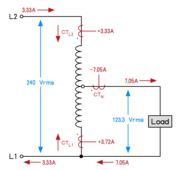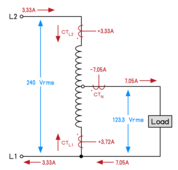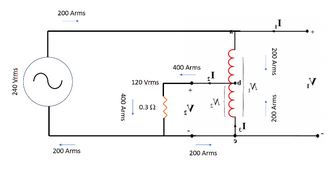Hedges
I See Electromagnetic Fields!
- Joined
- Mar 28, 2020
- Messages
- 20,761
Transformers aren't well understood by most people who use them.
It is well known that centertap "Neutral" connection carries the difference between L1 and L2, but that is not at all true for autotransformers. It is only true for the case of an isolation transformer where all power is delivered to the primary (e.g. from the grid.) If an isolation transformer is backfed (e.g. by grid tie photovoltaic inverter), it is no longer true.
In an autotransformer, the centertap neutral current is the sum of L1 and L2. L1 equals L2. L1 and L2 are (approximately) zero unless there is a load that draws current from neutral. I say "approximately", because real transformers aren't ideal, and manufacturing makes a tradeoff between performance, and cost/size; see link below under "References".
After debating this issue to no end with other electrically experienced members on the forum, I finally wasted a morning putting my measurement where my mouth is.
Consider a 120V load (oil filled radiator), 240V source (grid L1/L2), and autotransformer (Two 240V primary windings of 240/480V to 120/240V transformer in series, secondary open circuit.) Note that the source is ground referenced, unlike a typical European 240V inverter with its "N" output disconnected from ground - for this reason I did NOT bond centertap N to G as you normally would.
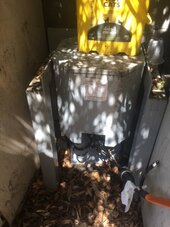


For this test, 15A breaker fed 240V L1/L2 to autotransformer, but N was not connected to grid.
Three CT (333mV/100A) were installed on L1/N/L2 of auto-transformer, all pointing toward auto-transformer
L1 from breaker also feeds hot pin of an outlet (not through CT). N coming back from auto-transformer goes through CT to neutral of outlet.
Electric heater is plugged into outlet, and scope voltage probe is also plugged in.
In screen shot, trace #1 shows L1 to N is 123.3 Vrms,
L1 current into auto-transformer is in phase, 3.72A ("V" means "A"),
N current into auto-transformer is out of phase 7.05A (so -7.05A)
L2 current into auto-transformer is in phase, 3.33A
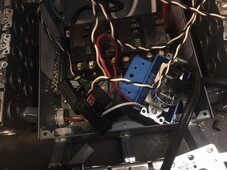
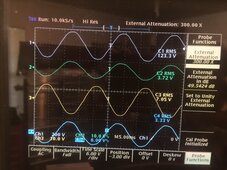
Note that 3.72A + 3.33A = 7.05A, so Kirchhoff's current law holds true!
Ordinarily, if you connected a load across 240V L1/L2, you would expect current to flow in L1, out L2. Then when polarity of AC reverses, in L2 and out L1.
The key thing to note is that does NOT occur here [in the case of auto-transformer as "load"]. Current flows in L1 AND in L2. It flows out N.
The load applied between N and L1 causes current to flow from L2, through transformer winding, out N, through the load, back to grid on L1.
That current flows through transformer winding ONLY because (approximately?) equal current also flows through the other winding in the opposite direction.
I understand all of this hurts your head. I had trouble wrapping my mind around it (and for real fun, study "hysteresis" and "saturation"; you can even use transformers in place of transistors to dim stage lighting or modulate AM radio broadcasts!
But the following diagram actually makes autotransformer operation clear. If you can give up preconceived notions.

References:

 diysolarforum.com
diysolarforum.com
It is well known that centertap "Neutral" connection carries the difference between L1 and L2, but that is not at all true for autotransformers. It is only true for the case of an isolation transformer where all power is delivered to the primary (e.g. from the grid.) If an isolation transformer is backfed (e.g. by grid tie photovoltaic inverter), it is no longer true.
In an autotransformer, the centertap neutral current is the sum of L1 and L2. L1 equals L2. L1 and L2 are (approximately) zero unless there is a load that draws current from neutral. I say "approximately", because real transformers aren't ideal, and manufacturing makes a tradeoff between performance, and cost/size; see link below under "References".
After debating this issue to no end with other electrically experienced members on the forum, I finally wasted a morning putting my measurement where my mouth is.
Consider a 120V load (oil filled radiator), 240V source (grid L1/L2), and autotransformer (Two 240V primary windings of 240/480V to 120/240V transformer in series, secondary open circuit.) Note that the source is ground referenced, unlike a typical European 240V inverter with its "N" output disconnected from ground - for this reason I did NOT bond centertap N to G as you normally would.



For this test, 15A breaker fed 240V L1/L2 to autotransformer, but N was not connected to grid.
Three CT (333mV/100A) were installed on L1/N/L2 of auto-transformer, all pointing toward auto-transformer
L1 from breaker also feeds hot pin of an outlet (not through CT). N coming back from auto-transformer goes through CT to neutral of outlet.
Electric heater is plugged into outlet, and scope voltage probe is also plugged in.
In screen shot, trace #1 shows L1 to N is 123.3 Vrms,
L1 current into auto-transformer is in phase, 3.72A ("V" means "A"),
N current into auto-transformer is out of phase 7.05A (so -7.05A)
L2 current into auto-transformer is in phase, 3.33A


Note that 3.72A + 3.33A = 7.05A, so Kirchhoff's current law holds true!
Ordinarily, if you connected a load across 240V L1/L2, you would expect current to flow in L1, out L2. Then when polarity of AC reverses, in L2 and out L1.
The key thing to note is that does NOT occur here [in the case of auto-transformer as "load"]. Current flows in L1 AND in L2. It flows out N.
The load applied between N and L1 causes current to flow from L2, through transformer winding, out N, through the load, back to grid on L1.
That current flows through transformer winding ONLY because (approximately?) equal current also flows through the other winding in the opposite direction.
I understand all of this hurts your head. I had trouble wrapping my mind around it (and for real fun, study "hysteresis" and "saturation"; you can even use transformers in place of transistors to dim stage lighting or modulate AM radio broadcasts!
But the following diagram actually makes autotransformer operation clear. If you can give up preconceived notions.

References:

transformer excitation current - isolation transformer used as auto-transformer
So you think you can backfeed a transformer secondary, either as step-up or as auto-transformer? Turns out these things aren't so ideal and reversible as one might expect. It isn't just the greater inrush (primary is often wound outside secondary to reduce inrush current), but also idle current...
Last edited:



